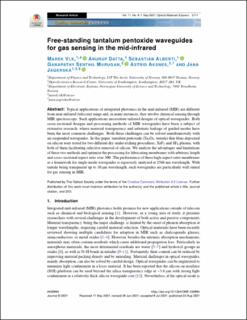| dc.contributor.author | Vlk, Marek | |
| dc.contributor.author | Datta, Anurup | |
| dc.contributor.author | Alberti, Sebastian | |
| dc.contributor.author | Murugan, Ganapathy Senthil | |
| dc.contributor.author | Aksnes, Astrid | |
| dc.contributor.author | Jagerska, Jana | |
| dc.date.accessioned | 2021-09-15T08:30:56Z | |
| dc.date.available | 2021-09-15T08:30:56Z | |
| dc.date.created | 2021-08-24T10:38:20Z | |
| dc.date.issued | 2021 | |
| dc.identifier.citation | Optical Materials Express. 2021, 11 (9), 3111-3124. | en_US |
| dc.identifier.issn | 2159-3930 | |
| dc.identifier.uri | https://hdl.handle.net/11250/2777340 | |
| dc.description.abstract | Typical applications of integrated photonics in the mid-infrared (MIR) are different from near-infrared (telecom) range and, in many instances, they involve chemical sensing through MIR spectroscopy. Such applications necessitate tailored designs of optical waveguides. Both cross-sectional designs and processing methods of MIR waveguides have been a subject of extensive research, where material transparency and substrate leakage of guided modes have been the most common challenges. Both these challenges can be solved simultaneously with air-suspended waveguides. In this paper, tantalum pentoxide (Ta2O5, tantala) thin films deposited on silicon were tested for two different dry under-etching procedures, XeF2 and SF6 plasma, with both of them facilitating selective removal of silicon. We analyze the advantages and limitations of these two methods and optimize the processing for fabricating membranes with arbitrary length and cross-sectional aspect ratio over 300. The performance of these high-aspect-ratio membranes as a framework for single-mode waveguides is rigorously analyzed at 2566 nm wavelength. With tantala being transparent up to 10 µm wavelength, such waveguides are particularly well suited for gas sensing in MIR. | en_US |
| dc.language.iso | eng | en_US |
| dc.publisher | OSA Publishing | en_US |
| dc.rights | Navngivelse 4.0 Internasjonal | * |
| dc.rights.uri | http://creativecommons.org/licenses/by/4.0/deed.no | * |
| dc.title | Free-standing tantalum pentoxide waveguides for gas sensing in the mid-infrared | en_US |
| dc.type | Peer reviewed | en_US |
| dc.type | Journal article | en_US |
| dc.description.version | publishedVersion | en_US |
| dc.source.pagenumber | 3111-3124 | en_US |
| dc.source.volume | 11 | en_US |
| dc.source.journal | Optical Materials Express | en_US |
| dc.source.issue | 9 | en_US |
| dc.identifier.doi | 10.1364/OME.430994 | |
| dc.identifier.cristin | 1928230 | |
| dc.relation.project | Tromsø forskningsstiftelse: 17_SG_JJ | en_US |
| dc.relation.project | ERC-European Research Council: 758973 | en_US |
| dc.relation.project | Engineering and Physical Sciences Research Council (EPSRC): EP/N00762X/1 | en_US |
| dc.relation.project | Norges forskningsråd: 262608 | en_US |
| dc.relation.project | Norges forskningsråd: 295864 | en_US |
| dc.relation.project | Norges forskningsråd: 221860 | en_US |
| dc.description.localcode | Published by The Optical Society under the terms of the Creative Commons Attribution 4.0 License. Further distribution of this work must maintain attribution to the author(s) and the published article's title, journal citation, and DOI. | en_US |
| cristin.ispublished | true | |
| cristin.fulltext | original | |
| cristin.qualitycode | 1 | |

